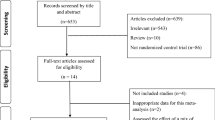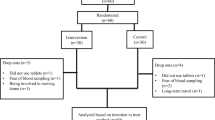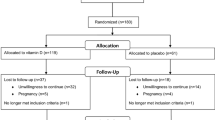Abstract
Magnesium (Mg) is the second most frequent intracellular cation in humans with a critical role in insulin metabolism and glucoregulation. Women with polycystic ovary syndrome (PCOS) often present with insulin resistance and impaired glucoregulatory status; however, their Mg status remains unclear. Therefore, we aimed to conduct a systematic review and meta-analysis to evaluate serum Mg concentration in women with PCOS and compare it with that of controls without PCOS. Online databases of PubMed, Scopus, Cochrane Library, and ISI Web of Science were searched for studies evaluating the relationship between Mg concentrations and PCOS status until October 2019. Pooled weighted mean differences (WMDs) of serum Mg levels were calculated using random effects models. A total of eight studies (10 arms; n = 2026 women) were included. Pooled effect sizes, expressed as WMD and 95% CI, revealed decreased serum Mg concentrations in women with PCOS compared with controls (− 0.09 (− 0.17, − 0.02) mmol/L; P = 0.01). However, significant heterogeneity was detected across the studies (I 2 = 98.0%, P < 0.001). Despite the classification of studies based on baseline BMI classes, we did not detect the potential source of the observed heterogeneity. Subgroup analysis showed that overweight and obese women (BMI ≥ 25 kg/m2, 0.07 mmol/L (− 0.14, − 0.01); P = 0.02) with PCOS had lower magnesium concentrations than normal women (BMI < 25 kg/m2, − 0.11 (− 0.25, 0.04) mmol/L; P = 0.14) compared with the control group. Serum Mg concentrations appear to be declined in overweight or obese women with PCOS, which may warrant screening and management of Mg status in this clinical population. High-quality studies are needed to elucidate the relationship between Mg concentrations and the development of PCOS.



Similar content being viewed by others
References
March WA et al (2009) The prevalence of polycystic ovary syndrome in a community sample assessed under contrasting diagnostic criteria. Hum Reprod 25(2):544–551
Teede HJ, Misso ML, Costello MF, Dokras A, Laven J, Moran L, Piltonen T, Norman RJ, International PCOS Network, Andersen M, Azziz R, Balen A, Baye E, Boyle J, Brennan L, Broekmans F, Dabadghao P, Devoto L, Dewailly D, Downes L, Fauser B, Franks S, Garad RM, Gibson-Helm M, Harrison C, Hart R, Hawkes R, Hirschberg A, Hoeger K, Hohmann F, Hutchison S, Joham A, Johnson L, Jordan C, Kulkarni J, Legro RS, Li R, Lujan M, Malhotra J, Mansfield D, Marsh K, McAllister V, Mocanu E, Mol BW, Ng E, Oberfield S, Ottey S, Peña A, Qiao J, Redman L, Rodgers R, Rombauts L, Romualdi D, Shah D, Speight J, Spritzer PM, Stener-Victorin E, Stepto N, Tapanainen JS, Tassone EC, Thangaratinam S, Thondan M, Tzeng CR, van der Spuy Z, Vanky E, Vogiatzi M, Wan A, Wijeyaratne C, Witchel S, Woolcock J, Yildiz BO (2018) Recommendations from the international evidence-based guideline for the assessment and management of polycystic ovary syndrome. Hum Reprod 33(9):1602–1618
Yanes Cardozo LL, Romero DG, Reckelhoff JF (2017) Cardiometabolic features of polycystic ovary syndrome: role of androgens. Physiology 32(5):357–366
Kazemi M, et al. (2019) Comprehensive evaluation of type 2 diabetes and cardiovascular disease risk profiles in reproductive-age women with polycystic ovary syndrome: a large Canadian cohort. J Obstet Gynaecol Can
Chakraborty P, Ghosh S, Goswami SK, Kabir SN, Chakravarty B, Jana K (2013) Altered trace mineral milieu might play an aetiological role in the pathogenesis of polycystic ovary syndrome. Biol Trace Elem Res 152(1):9–15
Pourteymour Fard Tabrizi F et al (2013) Minerals status in women with polycystic ovary syndrome. KAUMS J (FEYZ) 16(7):677–678
Kurdoglu Z, Kurdoglu M, Demir H, Sahin HG (2012) Serum trace elements and heavy metals in polycystic ovary syndrome. Hum Exp Toxicol 31(5):452–456
Abedini M, Ghaedi E, Hadi A, Mohammadi H, Amani R (2019) Zinc status and polycystic ovarian syndrome: a systematic review and meta-analysis. J Trace Elem Med Biol 52:216–221
Guler I, Himmetoglu O, Turp A, Erdem A, Erdem M, Onan MA, Taskiran C, Taslipinar MY, Guner H (2014) Zinc and homocysteine levels in polycystic ovarian syndrome patients with insulin resistance. Biol Trace Elem Res 158(3):297–304
Kanafchian M, Mahjoub S, Esmaeilzadeh S, Rahsepar M, Mosapour A (2018) Status of serum selenium and zinc in patients with the polycystic ovary syndrome with and without insulin resistance. Middle East Fertil Soc J 23(3):241–245
Rodríguez-Morán M et al (2012) The role of magnesium in type 2 diabetes: a brief based-clinical review. Magnes Res 24(4):156–162
Kauffman RP et al (2011) Serum magnesium concentrations and metabolic variables in polycystic ovary syndrome. Acta Obstet Gynecol Scand 90(5):452–458
Cinar V, Polat Y, Baltaci AK, Mogulkoc R (2011) Effects of magnesium supplementation on testosterone levels of athletes and sedentary subjects at rest and after exhaustion. Biol Trace Elem Res 140(1):18–23
Maggio M, de Vita F, Lauretani F, Nouvenne A, Meschi T, Ticinesi A, Dominguez LJ, Barbagallo M, Dall’Aglio E, Ceda GP (2014) The interplay between magnesium and testosterone in modulating physical function in men. Int J Endocrinol 2014:1–9
Al-Ghamdi SM, Cameron EC, Sutton RA (1994) Magnesium deficiency: pathophysiologic and clinical overview. Am J Kidney Dis 24(5):737–752
Schlingmann KP, Konrad M, Seyberth HW (2004) Genetics of hereditary disorders of magnesium homeostasis. Pediatr Nephrol 19(1):13–25
Shalev H, Phillip M, Galil A, Carmi R, Landau D (1998) Clinical presentation and outcome in primary familial hypomagnesaemia. Arch Dis Child 78(2):127–130
Elisaf M, Merkouropoulos M, Tsianos EV, Siamopoulos KC (1995) Pathogenetic mechanisms of hypomagnesemia in alcoholic patients. J Trace Elem Med Biol 9(4):210–214
Shah G, Kirschenbaum M (1991) Renal magnesium wasting associated with therapeutic agents. Miner Electrolyte Metab 17(1):58–64
Rylander R (1996) Environmental magnesium deficiency as a cardiovascular risk factor. J Cardiovasc Risk 3(1):4–10
Flink EB (1981) Magnesium deficiency. Etiology and clinical spectrum. Acta Med Scand 209(S647):125–137
Sillo T et al (2017) Pre-and post-operative hypomagnesaemia and association with adverse outcomes in elective vascular surgery, 1356. Clin Surg:2
Smith WO (1963) Magnesium deficiency in the surgical patient. Am J Cardiol 12(5):667–670
Song Y, Li TY, van Dam RM, Manson JAE, Hu FB (2007) Magnesium intake and plasma concentrations of markers of systemic inflammation and endothelial dysfunction in women. Am J Clin Nutr 85(4):1068–1074
Guerrero-Romero F, Tamez-Perez HE, González-González G, Salinas-Martínez AM, Montes-Villarreal J, Treviño-Ortiz JH, Rodríguez-Morán M (2004) Oral magnesium supplementation improves insulin sensitivity in non-diabetic subjects with insulin resistance. A double-blind placebo-controlled randomized trial. Diabetes Metab 30(3):253–258
ELDerawi W et al (2019) The effects of oral magnesium supplementation on glycemic response among type 2 diabetes patients. Nutrients 11(1):44
Hamilton KP et al (2019) Insulin resistance and serum magnesium concentrations among women with polycystic ovary syndrome. Curr Dev Nutr 3(11):nzz108
Rodríguez-Morán M, Guerrero-Romero F (2003) Oral magnesium supplementation improves insulin sensitivity and metabolic control in type 2 diabetic subjects: a randomized double-blind controlled trial. Diabetes Care 26(4):1147–1152
Cahill F, et al. (2013) High dietary magnesium intake is associated with low insulin resistance in the Newfoundland population. PLoS One. 8(3)
Guerrero-Romero F, Simental-Mendía LE, Hernández-Ronquillo G, Rodriguez-Morán M (2015) Oral magnesium supplementation improves glycaemic status in subjects with prediabetes and hypomagnesaemia: a double-blind placebo-controlled randomized trial. Diabetes Metab 41(3):202–207
Kostov K (2019) Effects of magnesium deficiency on mechanisms of insulin resistance in type 2 diabetes: focusing on the processes of insulin secretion and signaling. Int J Mol Sci 20(6):1351
Nestler JE (2000) Insulin resistance and the polycystic ovary syndrome: recent advances. Curr Opin Endocrinol Diabetes Obes 7(6):345–349
Marshall J, Dunaif A (2012) Аll women with PCOS should be treated for insulin resistance. Fertil Steril 97(1):18–22
Rojas J, Chávez M, Olivar L, Rojas M, Morillo J, Mejías J, Calvo M, Bermúdez V (2014) Polycystic ovary syndrome, insulin resistance, and obesity: navigating the pathophysiologic labyrinth. Int J Reprod Med 2014:1–17
Levin G, Mather H, Pilkington T (1981) Tissue magnesium status in diabetes mellitus. Diabetologia 21(2):131–134
Asemi Z, Esmaillzadeh A (2015) DASH diet, insulin resistance, and serum hs-CRP in polycystic ovary syndrome: a randomized controlled clinical trial. Horm Metab Res 47(03):232–238
Szczuko M et al. (2016) Quantitative assessment of nutrition in patients with polycystic ovary syndrome (PCOS). Roczniki Państwowego Zakładu Higieny. 67(4)
Kanafchian M et al. (2019) Status of serum copper, magnesium, and total antioxidant capacity in patients with polycystic ovary syndrome. Biol Trace Elem Res, p. 1–7
Muneyyirci-Delale O, Nacharaju VL, Dalloul M, Jalou S, Rahman M, Altura BM, Altura BT (2001) Divalent cations in women with PCOS: implications for cardiovascular disease. Gynecol Endocrinol 15(3):198–201
Sharifi F, Mazloomi S, Hajihosseini R, Mazloomzadeh S (2012) Serum magnesium concentrations in polycystic ovary syndrome and its association with insulin resistance. Gynecol Endocrinol 28(1):7–11
Picot J et al. (2012) The preferred reporting items for systematic reviews and meta-analyses checklist, in The effectiveness of interventions to treat severe acute malnutrition in young children: a systematic review, NIHR J Libr
Stang A (2010) Critical evaluation of the Newcastle-Ottawa scale for the assessment of the quality of nonrandomized studies in meta-analyses. Eur J Epidemiol 25(9):603–605
Li M, Tang Y, Lin C, Huang Q, Lei D, Hu Y (2017) Serum macroelement and microelement concentrations in patients with polycystic ovary syndrome: a cross-sectional study. Biol Trace Elem Res 176(1):73–80
Rajeswari G et al (2016) Study of magnesium levels in polycystic ovarian syndrome. IJAR 2(3):610–613
Azziz R (2006) Diagnosis of polycystic ovarian syndrome: the Rotterdam criteria are premature. J Clin Endocrinol Metabol 91(3):781–785
Guerrero-Romero F, Rodriguez-Moran M (2013) Serum magnesium in the metabolically-obese normal-weight and healthy-obese subjects. Eur J Intern Med 24(7):639–643
Hoeger KM (2007) Obesity and lifestyle management in polycystic ovary syndrome. Clin Obstet Gynecol 50(1):277–294
Durmus U, Duran C, Ecirli S (2017) Visceral adiposity index levels in overweight and/or obese, and non-obese patients with polycystic ovary syndrome and its relationship with metabolic and inflammatory parameters. J Endocrinol Investig 40(5):487–497
Barbagallo M, Dominguez LJ (2007) Magnesium metabolism in type 2 diabetes mellitus, metabolic syndrome and insulin resistance. Arch Biochem Biophys 458(1):40–47
Kostov K (2019) Effects of magnesium deficiency on mechanisms of insulin resistance in type 2 diabetes: focusing on the processes of insulin secretion and signaling. Int J Mol Sci. 20(6)
Chutia H, Lynrah KG (2015) Association of serum magnesium deficiency with insulin resistance in type 2 diabetes mellitus. J Lab Physicians 7(2):75–78
Kauffman RP et al. (2011) Serum magnesium concentrations and metabolic variables in polycystic ovary syndrome. 90(5): p. 452–458
Bertinato J, Xiao CW, Ratnayake WMN, Fernandez L, Lavergne C, Wood C, Swist E (2015) Lower serum magnesium concentration is associated with diabetes, insulin resistance, and obesity in South Asian and white Canadian women but not men. Food Nutr Res 59(1):25974
Lim SS et al. (2012) Overweight, obesity and central obesity in women with polycystic ovary syndrome: a systematic review and meta-analysis. 18(6): p. 618–637
Morais JBS, Severo JS, de Alencar GRR, de Oliveira ARS, Cruz KJC, Marreiro DN, Freitas BJSA, de Carvalho CMR, Martins MCC, Frota KMG (2017) Effect of magnesium supplementation on insulin resistance in humans: a systematic review. Nutrition 38:54–60
Jamilian M et al (2019) The effect of magnesium and vitamin E co-supplementation on glycemic control and markers of cardio-metabolic risk in women with polycystic ovary syndrome: a randomized, double-blind. Placebo-Controlled Trial 51(02):100–105
Zheltova AA et al. (2016) Magnesium deficiency and oxidative stress: an update. BioMedicine. 6(4)
Oliveira ARSd et al (2017) Hypomagnesemia and its relation with chronic low-grade inflammation in obesity. Rev Assoc Med Bras 63(2):156–163
Romani AM (2013) Magnesium in health and disease, in Interrelations between essential metal ions and human diseases, Springer. p. 49–79
Escobar-Morreale HF, Luque-Ramirez M, Gonzalez F (2011) Circulating inflammatory markers in polycystic ovary syndrome: a systematic review and metaanalysis. Fertil Steril. 95(3): p. 1048–58.e1–2
Sathyapalan T, Atkin SL (2010) Mediators of inflammation in polycystic ovary syndrome in relation to adiposity. Mediat Inflamm 2010:758656–758656
Papalou O, Victor VM, Diamanti-Kandarakis E (2016) Oxidative stress in polycystic ovary syndrome. Curr Pharm Des 22(18):2709–2722
Mohammadi M (2019) Oxidative stress and polycystic ovary syndrome: a brief review. Int J Prev Med 10:86–86
Long S, Romani AM (2014) Role of cellular magnesium in human diseases. Austin J Nutr Food Sci 2(10):1051
Ebrahimi FA et al. (2018) The effects of magnesium and zinc co-supplementation on biomarkers of inflammation and oxidative stress, and gene expression related to inflammation in polycystic ovary syndrome: a randomized controlled clinical trial. 184(2): p. 300–307
Cutler DA, Pride SM, Cheung AP (2019) Low intakes of dietary fiber and magnesium are associated with insulin resistance and hyperandrogenism in polycystic ovary syndrome: a cohort study. 7(4): p. 1426–1437
Lin AW, Kazemi M, Jarrett BY, vanden Brink H, Hoeger KM, Spandorfer SD, Lujan ME (2019) Dietary and physical activity behaviors in women with polycystic ovary syndrome per the new international evidence-based guideline. Nutrients 11(11):2711
Author information
Authors and Affiliations
Contributions
HM and MB contributed to the conception of research. HM and MB searched databases, screened articles, and extracted data. HM performed the statistical analyses, and all authors contributed to the writing and revision of the manuscript.
Corresponding author
Additional information
Publisher’s Note
Springer Nature remains neutral with regard to jurisdictional claims in published maps and institutional affiliations.
Rights and permissions
About this article
Cite this article
Babapour, M., Mohammadi, H., Kazemi, M. et al. Associations Between Serum Magnesium Concentrations and Polycystic Ovary Syndrome Status: a Systematic Review and Meta-analysis. Biol Trace Elem Res 199, 1297–1305 (2021). https://doi.org/10.1007/s12011-020-02275-9
Received:
Accepted:
Published:
Issue Date:
DOI: https://doi.org/10.1007/s12011-020-02275-9




